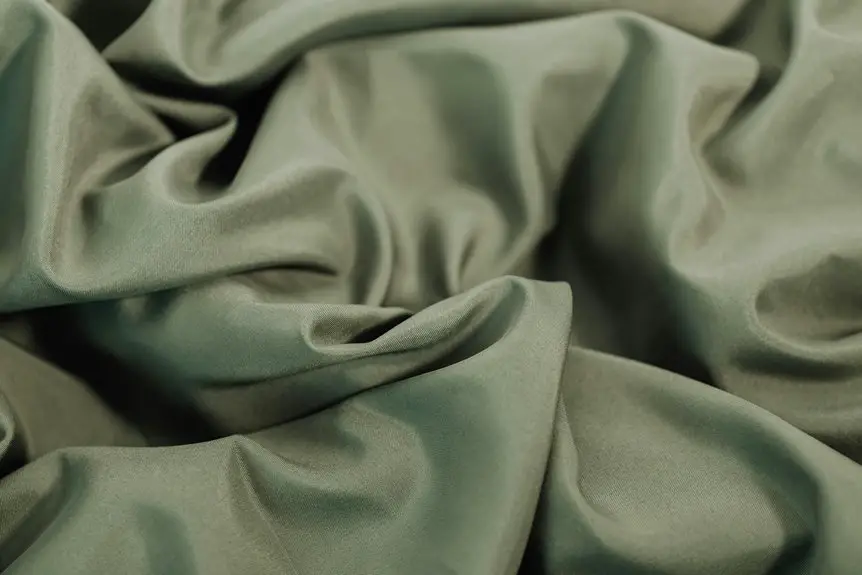You’ll want to know Crepe De Chine, Georgette Crepe, Silk Crepe, Wool Crepe, and Synthetic Crepe for their unique textures and uses. Don’t miss Crêpe Back Satin’s luxe finish, Heavyweight Crepe for structure, Stretch Crepe’s elasticity, and Printed Crepe’s vibrant patterns. Each offers different drape, durability, and care needs, making it easier to pick the perfect fabric for your project. Keep exploring, and you’ll find the ideal crepe style for any garment you imagine.
Table of Contents
Key Takeaways
- Crepe De Chine is lightweight, smooth, and elegant with a subtle matte finish, ideal for blouses, dresses, and scarves.
- Georgette Crepe is airy and semi-sheer with a crinkled texture, perfect for flowy dresses and delicate garments.
- Crêpe Back Satin combines a satin finish with crepe texture, offering wrinkle resistance and a lustrous look for formal wear.
- Wool Crepe provides warmth and structure with a soft, crinkled surface, suitable for suits and cold-weather garments.
- Stretch Crepe adds elasticity to classic texture, enhancing comfort and wrinkle resistance for dresses and tailored pieces.
Crepe De Chine
Crepe de Chine offers a lightweight, smooth texture that feels soft against your skin.
You’ll appreciate its subtle matte finish and slightly crinkled surface, which gives it a unique elegance without being flashy.
This fabric drapes beautifully, making it a favorite for blouses, dresses, and scarves that flow effortlessly.
Because it’s woven with fine silk or synthetic fibers, it combines durability with a luxurious touch.
You won’t have to worry about it feeling heavy or stiff—the breathable nature keeps you comfortable all day.
Plus, Crepe de Chine resists wrinkles better than many other silks, so your garments stay polished longer.
Whether you’re dressing up or down, this fabric lends sophistication with ease, making it a versatile addition to your wardrobe.
Georgette Crepe
Light and airy, Georgette Crepe delivers a slightly rough texture that adds character without sacrificing softness.
When you choose Georgette, you get a lightweight fabric that drapes beautifully, making it perfect for flowy dresses, blouses, and scarves.
Its distinct crinkled surface comes from tightly twisted yarns woven loosely, giving it that signature pebbly feel. You’ll notice it’s semi-sheer, so layering is often necessary depending on your project.
Georgette is usually made from silk or polyester, which means it resists wrinkles and moves gracefully with you.
If you want a fabric that combines elegance with a bit of texture, Georgette Crepe is an excellent pick.
Just be mindful—it can be delicate, so handle it gently when sewing or washing.
Silk Crepe
When you touch silk crepe, you’ll notice its soft, slightly crinkled texture that feels luxurious against your skin.
You’ll often find it used in elegant dresses and scarves because of its graceful drape.
To keep it looking its best, you’ll want to handle it gently and follow specific care instructions.
Texture and Feel
The unique texture of silk crepe draws you in with its slightly crinkled surface that feels both soft and substantial to the touch.
When you run your fingers over it, you notice a subtle graininess that adds character without roughness. This fabric has a natural elasticity, giving it a gentle bounce that enhances comfort and movement.
Unlike smooth silks, silk crepe doesn’t cling tightly, allowing for airflow and breathability. Its matte finish prevents excess shine, making it versatile for different styles.
You’ll find the weight to be light yet durable, striking a balance that feels luxurious but practical.
Common Uses
Silk crepe’s unique texture and comfortable feel make it a popular choice for various garments. When you choose silk crepe, you’re getting fabric that drapes beautifully, perfect for elegant dresses, blouses, and skirts.
It’s lightweight yet durable, so it works well for both casual and formal wear. You’ll also find silk crepe in scarves and evening gowns, where its subtle crinkle adds visual interest without overwhelming the design.
Because it flows so gracefully, designers often use it for wrap dresses and loose-fitting tops. If you want a fabric that combines sophistication with comfort, silk crepe fits the bill.
Its versatility means you can confidently wear it for work, special occasions, or relaxed outings, making it a valuable addition to your wardrobe.
Care and Maintenance
To keep your silk crepe looking its best, handle it with care during cleaning and storage. Always check the care label first, as silk crepe is delicate and can easily lose its texture if treated improperly.
When washing, opt for gentle hand washing in cold water with mild detergent or dry cleaning for stubborn stains. Avoid wringing; instead, press out excess water gently.
Store silk crepe in a cool, dry place away from direct sunlight to prevent fading and fabric damage.
- Hand wash with cold water and mild detergent
- Avoid wringing; gently press out water
- Use a padded hanger or fold carefully to prevent creases
- Keep away from direct sunlight
- Dry clean when necessary to maintain fabric quality
Following these tips will help your silk crepe remain vibrant and soft.
Wool Crepe
Wool crepe offers a unique texture that combines warmth with elegance, making it a favorite for cooler seasons. You’ll find it perfect for suits, skirts, and dresses that need structure without stiffness. Its slightly crinkled surface adds interest while maintaining a soft hand feel. Wool crepe drapes beautifully and resists wrinkles, so you’ll look polished all day.
| Feature | Description |
|---|---|
| Fiber | 100% Wool |
| Texture | Grainy, pebbled surface |
| Warmth | High, ideal for cold weather |
| Common Uses | Coats, suits, formal wear |
When you pick wool crepe, you get durability and breathability, too—perfect for staying comfortable and stylish.
Synthetic Crepe
While wool crepe excels in warmth and natural texture, synthetic crepe offers a different set of benefits that might catch your eye.
Made from man-made fibers like polyester or nylon, synthetic crepe is lightweight and often more affordable. It’s also highly durable and resists wrinkles, making it perfect for everyday wear or travel.
Synthetic crepe, crafted from polyester or nylon, offers lightweight durability and wrinkle resistance—ideal for daily wear and travel.
You’ll appreciate how easy it’s to care for synthetic crepe since it dries quickly and holds color well. Plus, its versatility suits various styles, from casual to formal.
Here’s what you should know about synthetic crepe:
- Lightweight yet strong fabric
- Wrinkle-resistant and easy to maintain
- Quick drying and colorfast
- Affordable alternative to natural crepes
- Versatile for multiple fashion uses
Crêpe Marocain
You’ll notice Crêpe Marocain has a distinct textured surface that sets it apart from other crepes.
It’s traditionally used in elegant garments and often made from silk or fine wool blends.
Understanding its fabric composition helps you appreciate why it feels both luxurious and durable.
Texture and Appearance
Although Crêpe Marocain may look simple at first glance, its texture reveals a unique pebbled surface that feels both crisp and slightly rough to the touch.
You’ll notice this fabric has a matte finish, which helps it avoid any unwanted shine. The grainy texture adds depth and character, making it stand out from smoother crepes. When you run your fingers over it, the tiny irregularities create a subtle tactile interest without being overwhelming.
Its slightly stiff drape gives structure to garments, ensuring they hold shape well.
- Distinct pebbled, grainy texture
- Matte, non-reflective surface
- Slightly rough but crisp feel
- Structured drape with firmness
- Visual depth from irregularities
This texture and appearance make Crêpe Marocain a versatile fabric choice for elegant looks.
Traditional Uses
Crêpe Marocain has long served as a favored fabric for traditional garments, prized for its durability and elegant texture.
When you choose Crêpe Marocain, you’re tapping into a rich heritage of clothing like flowing abayas, kaftans, and other ceremonial robes. This fabric holds up well to daily wear, making it perfect for both casual and formal occasions in many Middle Eastern and North African cultures.
You’ll find it used in wedding attire and religious celebrations, where its graceful drape and subtle sheen add a refined touch.
Whether you’re making a statement piece or a comfortable everyday garment, Crêpe Marocain offers versatility and timeless style that honors tradition while fitting modern needs.
It’s a smart choice that blends heritage with practicality.
Fabric Composition
When you look closely at Crêpe Marocain, its unique texture comes from a blend of natural and synthetic fibers.
This fabric combines the softness and breathability of natural fibers with the durability and stretch of synthetics, giving you a versatile material perfect for elegant garments.
The composition typically includes:
- Silk or wool for a smooth, luxurious feel
- Rayon to enhance drape and sheen
- Polyester for strength and wrinkle resistance
- Nylon to add elasticity and resilience
- Cotton blends to improve comfort and moisture absorption
Crêpe Back Satin
You’ll appreciate Crêpe Back Satin for its unique combination of texture and sheen. One side features a smooth, glossy satin finish, while the reverse offers the characteristic crinkled crepe texture.
This duality gives you versatility, allowing the fabric to drape elegantly with just a subtle hint of texture. It’s lightweight yet durable, making it perfect for evening wear, bridal gowns, and stylish blouses.
When you work with Crêpe Back Satin, you’ll notice it resists wrinkles better than pure satin, thanks to the crepe backing. The fabric’s fluidity and lustrous surface help create sophisticated silhouettes, while the textured side adds depth.
Crêpe Back Satin combines wrinkle resistance with fluidity, crafting elegant silhouettes enriched by subtle texture.
If you want a fabric that balances glamour and practicality, Crêpe Back Satin is a smart choice.
Heavyweight Crepe
Heavyweight Crepe delivers a substantial feel that holds shape beautifully, making it ideal for structured garments like coats, trousers, and formal dresses.
When you choose this fabric, you get durability and elegance combined. It’s perfect when you need a fabric that won’t easily wrinkle or lose form throughout the day. The texture remains distinct without feeling stiff, giving your outfit a refined yet comfortable look.
Here’s why you might want to use Heavyweight Crepe:
- Excellent drape with firmness for tailored styles
- Resists wrinkles and maintains crisp lines
- Suitable for cooler weather due to its weight
- Offers a matte, slightly textured finish
- Works well for both casual and formal wear
You’ll appreciate how Heavyweight Crepe enhances your wardrobe’s versatility.
Stretch Crepe
Stretch Crepe combines the classic textured look of crepe with added elasticity, giving you greater freedom of movement and comfort. This fabric is perfect if you want the elegance of crepe but need a bit of stretch for active wear or fitted garments. It holds its shape well and drapes beautifully, making it ideal for dresses, blouses, and tailored pieces. Because it stretches, it also reduces wrinkling, so you’ll look polished throughout the day.
| Feature | Benefit | Ideal Use |
|---|---|---|
| Elastic fibers | Enhanced flexibility | Activewear, dresses |
| Textured surface | Classic crepe appearance | Formal and casualwear |
| Shape retention | Lasting fit and comfort | Tailored garments |
Printed Crepe
Printed Crepe adds a vibrant twist to the traditional crepe fabric by incorporating colorful patterns and designs. You’ll find it perfect for making standout dresses, blouses, and scarves that express personality and style.
The texture remains slightly crinkled, giving depth to the printed motifs. When you choose printed crepe, you get a fabric that’s lightweight, breathable, and drapes beautifully, making your creations both comfortable and eye-catching.
Here’s what you should know about printed crepe:
- Comes in various prints: florals, geometrics, abstracts
- Works well for casual and formal wear
- Retains crepe’s signature texture beneath prints
- Offers versatility in fashion and home decor
- Requires gentle care to preserve colors and fabric quality
Printed crepe lets you blend texture with vibrant visuals effortlessly.
Frequently Asked Questions
How Do You Care for and Wash Crepe Fabric?
You should hand wash crepe fabric in cold water with mild detergent. Avoid wringing; instead, gently squeeze out water. Hang it to dry away from direct sunlight to prevent fading and maintain its texture.
What Are the Best Clothing Items Made From Crepe?
Did you know crepe fabrics are 30% more breathable? You’ll love wearing crepe dresses, blouses, and suits—they drape beautifully and resist wrinkles, making your outfits stylish and comfortable for both work and special occasions.
Is Crepe Fabric Suitable for Summer or Winter Wear?
You can wear crepe fabric in both summer and winter. Its breathability suits warm weather, while thicker crepes provide warmth in colder months. Just pick the right crepe type to stay comfortable all year round.
Can Crepe Fabric Be Ironed Without Damage?
You can iron crepe fabric, but you need to be careful. Use a low heat setting, place a cloth between the iron and fabric, and avoid pressing too long to prevent damage or shiny spots on your garment.
How Does Crepe Fabric Compare in Price to Other Fabrics?
Like a mid-range meal, crepe fabric usually costs more than basic cotton but less than luxury silk. You’ll find it affordable yet elegant, striking a nice balance between price and quality for your projects.
- The Environmental Debate: Woven vs. Nonwoven Bags - July 12, 2025
- Woven vs. Nonwoven Bandages: A Medical Perspective - July 12, 2025
- How to Identify High-Quality Nonwoven Interfacing - July 12, 2025





